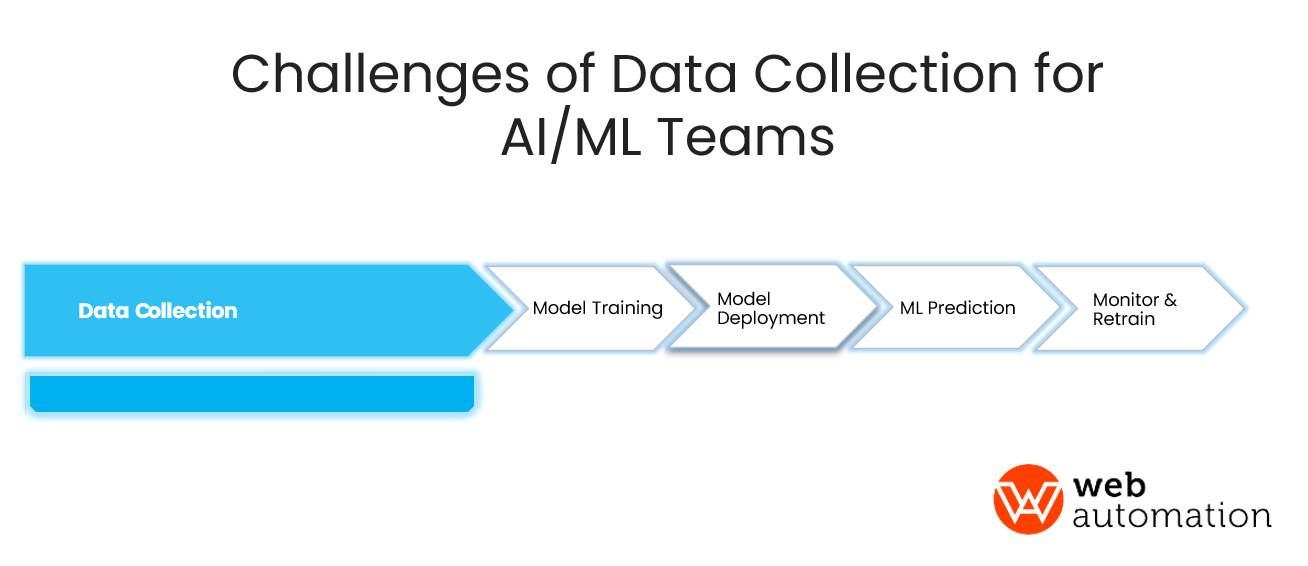
In the realm of AI and ML, effective data collection is crucial but often challenging. This article dives into the common obstacles faced by AI/ML teams when gathering data and provides insightful str
By Chatty @June, 23 2023

Data collection is a critical component of any AI/ML project. Imagine how difficult it would be to train and evaluate models without enough data! But, gathering the right data can become more complicated than anticipated. Although there are now tools for web scraping and data collection, AI/ML teams still face many challenges when collecting and preparing data for their projects. Here are some of the most common challenges they must overcome:
AI/ML teams collect data based on the objectives set for their projects. Unfortunately, it’s often difficult to find all the data they need in one place, with teams often requiring web scraping software. Additionally, many datasets are fragmented and not easily accessible, making it harder to get the data they need.
For example, government datasets may be difficult to obtain due to security concerns. Or, the data needed for a project may not be available in an accessible format, such as when web scraping multimedia files like audio or video recordings.
One way to resolve the challenge of data availability is through the use of open datasets. Open datasets are publicly available collections of data that anyone can use, share, and modify. Organizations such as Google and Microsoft provide access to a variety of open datasets that can be used for AI/ML projects. Also, organizations may be able to acquire the data they need through partnerships with other companies or data providers.
Data quality is another common challenge for AI/ML teams. AI/ML teams must ensure their data is of the highest quality and accuracy. Data must be properly labeled, formatted, and cleaned before it can be used effectively. When this is overlooked, the results can be disastrous. For instance, if your team uses web scraping tools that result in poorly formatted or incorrect data, it can lead to inaccurate results, leading to costly mistakes.
Data quality issues can also arise due to inconsistencies in data collection methods. If different people are collecting data using different tools or standards, for instance, the results may not be uniform across the dataset. Thus, AI/ML teams must develop a consistent approach to data collection to ensure that all data is collected accurately. To mitigate this risk, teams must also deploy strategies for validating, cleaning, and normalizing their data.
AI/ML teams must consider data privacy and security when collecting data. In some cases, the data may contain sensitive information such as names, addresses, phone numbers, or financial records. This information should be handled well to ensure it’s not misused or exposed to unauthorized individuals.
Keep in mind that data breaches can lead to financial losses. At the same time, it can cause reputational damage and customer attrition. Thus, teams must ensure to secure the data they collect and encrypt it while in transit or at rest.
One of the biggest security issues that AI/ML teams face is source code exfiltration. Source code exfiltration is the process of extracting source code from a system without authorization. It is a form of data theft, and it can have serious implications for a company's security.
This often occurs when an attacker gains access to sensitive internal systems., such as servers and databases. These attackers can then gain insight into how the system works and use it to their advantage.
To prevent source code exfiltration, teams must use security measures. These include encryption, authentication, access control lists (ACLs), regular audits, and system monitoring. Encrypting source code helps protect it from being accessed by anyone.
Authentication prevents access to the system from unauthorized users. While ACLs limit access to certain users or operation types. Regular audits ensure to track any changes made to the code. And system monitoring helps detect suspicious activity.
Data bias is when a dataset contains inaccurate or misrepresentative information. This information has the ability to skew results or decisions. For example, an AI/ML model is trained on a dataset that includes historical hiring data from a company's past practices. It may learn to replicate discriminatory hiring practices.
Data bias can be caused by a variety of factors, including sampling error, data collection methods, and human error. To mitigate these risks, teams must ensure to collect data in an unbiased manner. They must actively monitor their models for any signs of bias. Additionally, teams should consider using techniques such as oversampling and undersampling to reduce bias.
AI/ML teams must pay close attention to the risks associated with data quality, privacy, security, and bias. By taking the time to address these challenges, they can ensure their AI/ML projects are successful. This will result in producing accurate results that are free from bias.
Data collection is an essential part of any AI/ML project. But, the cost of acquiring, storing, and processing data can quickly add up! Depending on the scope and size of the project, teams may need to invest in specialized talent or infrastructure that can help them manage their data.
Thus, AI/ML teams must consider the cost of their projects when it comes to collecting data. Teams should also consider the cost of any third-party services, such as web scraping tools, that they may need to purchase to complete their projects.
It’s also important for AI/ML teams to factor in the long-term costs associated with their projects. They must consider not only the upfront costs but also the ongoing costs associated with maintaining and updating their systems.
AI/ML teams must take the time to consider several factors when developing their projects. These include data quality, privacy and security measures, bias, and cost. Teams can ensure their AI/ML systems are effective and secure when they take these factors into account.
Furthermore, they can make sure that their results are free from bias and accurately represent the data they’re using. By managing these challenges, AI/ML teams can create successful projects that produce accurate and useful results!
Q: What are the common challenges faced by AI/ML teams during data collection?
A: AI/ML teams often encounter challenges such as data quality issues, lack of diversity in datasets, privacy concerns, and scalability problems.
Q: How can data quality be improved during the collection process?
A: To improve data quality, teams can implement rigorous data validation techniques, perform thorough data cleaning and preprocessing, and ensure proper data annotation.
Q: What are some strategies to address the issue of dataset diversity?
A: Strategies to address dataset diversity include actively seeking diverse sources for data collection, incorporating data augmentation techniques, and considering biases and representation issues.
Q: How can privacy concerns be addressed while collecting data?
A: Privacy concerns can be addressed by anonymizing and aggregating sensitive data, adhering to data protection regulations, and obtaining proper consent from individuals involved in the data collection process.
Q: What approaches can be taken to handle the scalability challenges of data collection?
A: To handle scalability challenges, teams can leverage automation tools, utilize distributed computing frameworks, and explore crowd-sourcing or collaborative data collection approaches.
Q: Are there any best practices for data labeling during the collection process?
A: Best practices for data labeling include using clear and consistent labeling guidelines, involving human annotators with domain expertise, and conducting quality checks to ensure accurate labeling.
Q: How can AI/ML teams augment their datasets?
A: AI/ML teams can augment their datasets by utilizing techniques such as data synthesis, transfer learning, and active learning to enhance the size and diversity of their training data.
Q: What are the potential benefits of overcoming data collection challenges?
A: Overcoming data collection challenges enables AI/ML teams to build more robust and accurate models, improve decision-making processes, and unlock the full potential of their machine learning initiatives.